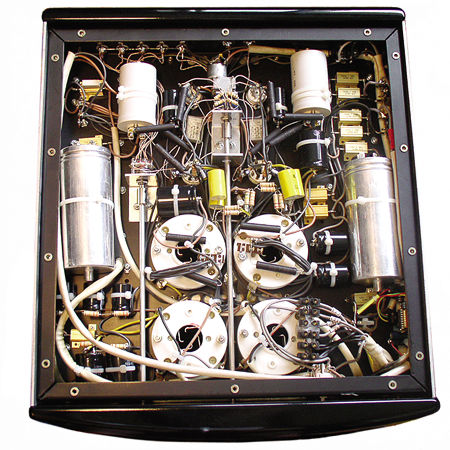| Columns Retired Columns & Blogs |
Listening #35 Page 2
So it goes with the Solista, which carries on the Viva tradition in every way: single-ended topology, directly heated output triodes, zero feedback, paper-in-oil capacitors, custom-wound transformers—and the same gorgeous metalwork, which manages to appear both organic and high-tech at the same time. (Schembri's architect girlfriend, Joëlle, contributed to the design.)
The Solista is a true integrated amplifier, not just a power amp with a passive front end. It has three active stages altogether: The input signal begins its journey at the potentiometer and, for voltage gain, goes on to a 6C45B triode—a tube of very low impedance. From there the music carries on to a 6H30 octal dual-triode, which Schembri describes as similar to the near-ubiquitous 6SN7, but with lower transconductance (and, he suggests, sweeter sound). The 6H30 drives the big 845 output triode, to which it is capacitor-coupled.
The power supply is distinguished by another Viva hallmark: tube rectification, using for the job a dual-mono pair of directly heated triodes (211s or another pair of 845s). From there it's a straightforward pi filter, albeit one with the unusual refinement of paper-in-oil capacitors.
Like all single-ended amplifiers of traditional (ie, non–parallel-feed) design, the Viva Solista requires two very large, air-gapped output transformers: In addition to passing an amplified audio signal of (hopefully) wide bandwidth, each transformer's primary must also carry the rail voltage from the power supply to the anode of its respective output tube—in the case of the 845 triode, a whopping 820V. The Solista's transformers are custom-made in Italy to Amedeo Schembri's exact specifications, said specs including the need for a single-wire primary and a single-wire secondary, with absolutely no breaks. The secondaries, in fact, are soldered directly to the loudspeaker connectors, also designed by Schembri: low-mass copper (to minimize eddy currents) plated with palladium for good conductivity and resistance to corrosion.

The Solista, which measures a generous 20" from front to back and weighs more than 90 lbs, is made entirely by hand, with point-to-point wiring (using Viva's own silk-insulated, high-purity copper) and an endearing mix of old and new technologies: logic parts for the optional remote control are only inches away from a phalanx of bypass capacitors damped with what appears to be wool felt. Throughout, the watchwords are simplicity and purity: Negative feedback is banished altogether, and passive filtering is applied to all the filament voltages in place of regulation—which Schembri says makes an amp sound terrible. The specified power output is 22Wpc into 8 ohms, the only load provided for—remember, there's only one secondary winding per transformer. There are four line-level inputs, alongside an extra pair that bypasses the potentiometer and first gain stage, so the Solista can be used as a power amp only. (In power-amp-only mode, with one fewer gain stage, the Solista inverts signal polarity, making it necessary to swap hot for ground and vice versa somewhere else in the chain. And by now, Clark Johnsen's ears are ringing off their hooks.)
The first time
It was cold outside the first time I heard a Solista: I was in Manhattan, visiting Ears Nova at their new Upper East Side loft, when owner Joshua Cohn—a Linn-Naim man of the first water—told me he'd finally found a tube amp he liked. No, make that loved. This I had to hear, so Joshua proceeded to play a June Tabor album through the Solista in one of the Ears Nova listening rooms, driving a big pair of Harbeth loudspeakers. It was magical.
Now I've spent a number of weeks—hot, humid weeks—using the Viva Solista in different settings. I tried it as just a power amp, driven by my Fi preamp and various other review samples that came though the door, and I got some good music out of it that way. But in the end, I decided that the Solista integrated, used as an integrated, towered over the Solista as a separate power amp, used with whatever else. That may be because Amedeo Schembri took great pains to ensure that the sounds of the Solista's own preamp and amp complemented one another, or it could be a simple matter of the input and output impedances of the different sections being optimized for each other. There were certainly none of the usual integrated-amp penalties with the self-contained Solista—meaning there was none of the hum and noise associated with suboptimal parts placement. In fact, the Solista proved to be one of the quietest SETs I've ever used, ranking in that regard alongside the combination of the Lamm ML2.1 monoblock amps and Lamm LL2 preamp.
The Solista, like that first SET Harvey heard, was consistently, impressively dramatic. When I listened to the version of "Ragtime Annie" from David Grier's Hootenanny (LP, Dreadnought 9801), it was easier than ever to hear when one or more of the players backed off, either to make room for someone else's solo or just as a means of dynamic shading: The effect was closer than usual to being in the room with them. At the other end of the spectrum, even driving my Quads, the Solista did a wonderful job tracing the many sharp jabs of sound—moments of violence, panic, fear, and outrage—in Hartmann's Symphony 2, as performed by Karl Anton Rickenbacher and the Bamberger Symphoniker (CD, Koch/Schwann 3-1295-2).
 An aside: I still like to listen with the windows wide open on summer mornings, and that's how it was today, when I went to play the Hartmann again. But as I was walking back to my chair after starting the CD, I noticed a group of wild turkeys on my property—and when the xylophone, glockenspiel, cymbals, and such made their first, loud entrance, those turkeys took off like the devil was coming after them with a can of cranberry sauce. I'm not saying that the turkeys ran faster from the sound of the Viva amp than they would have from, say, a Krell KSA-200. (I suppose I could have measured their speed and satisfied at least one portion of our readership.) I just thought it was interesting.
An aside: I still like to listen with the windows wide open on summer mornings, and that's how it was today, when I went to play the Hartmann again. But as I was walking back to my chair after starting the CD, I noticed a group of wild turkeys on my property—and when the xylophone, glockenspiel, cymbals, and such made their first, loud entrance, those turkeys took off like the devil was coming after them with a can of cranberry sauce. I'm not saying that the turkeys ran faster from the sound of the Viva amp than they would have from, say, a Krell KSA-200. (I suppose I could have measured their speed and satisfied at least one portion of our readership.) I just thought it was interesting.
Another fine thing about SETs is the way they can make even indifferently recorded pop music sound captivating and there—a good case in point being Martin Newell's charmingly sad "Wicked Witch," from his Radio Autumn Attic (CD, Cherry Red CDB RED 206). It sounds flat and fake through normal amps, but through the Solista it came to life: Voices and instruments became fatter, and small details, such as the squeak of fingers on wound strings, popped out the way such sounds do in real life.
The Solista's stereo imaging capabilities are also worth mentioning. Volume level for volume level, the big-sounding Viva brought instruments and voices forward a bit (albeit not as much as what I tend to associate with, say, those selfsame solid-state British amps known for their good timing characteristics) and endowed them with good wholeness and solidity. The voices in Matthew Locke's "How doth the city" (CD, Nimbus NI 5454) were pleasantly chunky and distinct from one another, spread across a stage that was larger than I'm used to hearing—although they didn't have quite as much of that realistic, hear-around spatial quality as through the Lamms. Oh well, whatcha gonna do. And on recordings in which the element of motion is crucial, such as Georg Solti and John Culshaw's famous Wagner Ring cycle (LPs, London OSA 1309, et al), the Viva did a superb job of following the action.
Complaints? Only the unsurprising observation that the Solista was often overfull in the bottom two octaves—too resonant, not quick enough in going from note attack to note attack. It definitely made the electric bass line in the Jayhawks' "Blue," from Tomorrow the Green Grass (LP, American 43006-1), sound sluggish. Likewise, it slowed the acoustic bass in Ricky Skaggs' brilliantly recorded version of "Walls of Time," from Ancient Tones (CD, Skaggs Family SKFR-CD 1001), which begins most measures by playing a double eighth note—something that's easier to hear through other amps.
But with an amp such as this, it always comes back down to two things for me: tone and presence. Tone, for me, is a roomy term comprising a great many things, including not only timbre but also a quality I tend to think of as richness, which encompasses a component's ability to present sonic details—not musical ones, in this instance—with not only a believable amount of texture but a believable depth of texture (in the sense that some corduroys or velvets are deeper than others). I begin by wondering, Do the strings sound stringy? Do reeds sound reedy? and so forth, but it can go a great deal deeper than that.
This sense of texture is both simpler and a lot more complex: Presence is presence, and I'm happy to leave it at that, in the assumption that you have both some sense of what I mean and some inclination to take my word for it when I say that something does or doesn't get it right. In any event, in both those sonic regards, the Solista satisfied me completely—as it did in the more elemental, musical sense of notes and beats, whereby the Solista made music consistently, unfailingly interesting and colorful.
So here I am on a summer night, which at this time of year is only slightly cooler than a summer afternoon. I'm listening to an old standby, not just because I love the music and I crave hearing it on a night like this, but because it sounds good and meshes nicely with an amp like this: Brahms' Clarinet Quintet on a 1962 Decca LP (SXL 2297). The rest of the family is in bed, sensibly enough, and if it were colder outside I'd be enjoying a nice whisky or something, and I might even be wearing my favorite burgundy paisley shirt. And now I'm wondering: How in the world could any sane person consider it wrong to buy whatever it is they enjoy, assuming that they can afford it, and that neither their buying decision nor the product itself will bring harm to anyone? Count me among the ones who think it's almost infinitely wronger, not to mention stupider, to do otherwise.
Next month: Nelson Pass's first single-ended amp in years.
- Log in or register to post comments




































